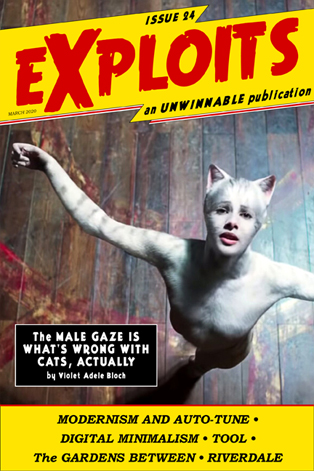
Modernism and Auto-Tune

This is a reprint of a feature story from Issue #24 of Exploits, our collaborative cultural diary in magazine form. If you like what you see, buy it now for $2, or subscribe to never miss an issue (note: Exploits is always free for subscribers of Unwinnable Monthly).
———
When Cher belted out “Believe” in 1998, she didn’t really need the help of auto-tune to hit the high notes. That extra little warble came thanks to producers Mark Taylor and Brian Rawlings who were interested in experimenting with the then unknown technology. Over the next two decades, auto-tune became one of the most contentious aspects of popular music, prompting Time Magazine to name it as one of The 50 Worst Inventions. This seems like an exaggeration to me for (at least) two reasons: 1) whales are literally choking to death on plastic, so something as innocuous as auto-tune really shouldn’t be mentioned in the realm of bad inventions; and 2) subsequent innovations with auto-tune in the two decades since Cher believed in life after love have shown that producers are using this little machine in a much more sophisticated way than you might believe.
Let’s quickly forget everything about auto-tune and go back to the first half of the 19th century, when a different piece of technology disrupted a different art form, namely, the photograph. Since around the 15th century, many painters had been working to perfect the idea of mimesis in their painting: they wanted to paint something that reflected real things that could exist. By the 19th century, they had gotten really good at it, specifically in the era of Neoclassicism and Romanticism. That’s not to say that these artists didn’t work in metaphors; it’s just that those metaphors took on romantic, representative manifestations (see Liberty Leading Its People in the header).

However, in the 1820s, Nicéphore Niépce developed the first photograph, changing the course of art forever. Within a century after his invention, the preferred style of painting changed from Rococo and Romanticism into fully-nonrepresentational art – abstract art. Within 100 years, we moved from the neoclassical representationalism of Eugène Delacroix to the abstract cubism of Pablo Picasso, from the realism of Gustave Courbet, to the German expressionism of Wassily Kandinsky. Now, there were certainly other social, cultural, and political factors at play in this shift towards abstraction, and I could go through decade by decade and show how this transformation happened, but I only have 800 words and this article is ostensibly about auto-tune, so I’ll let the images do the talking here.

 I see auto-tune playing the same role in hip hop in the last two decades as photography played in art in the 19th and early 20th century. Just as the camera perfected representationalism more than a painter ever could, so auto-tune perfected singing in the 2000s. No one needs to try and sing perfectly anymore because they can auto-tune the perfection. Just as artists in the late 19th century to pushed beyond the traditional boundaries of painting to focus on the formal elements of the art (the flatness of the canvas, the brush strokes of the paintbrush, the hand of the artists), so auto-tune has allowed rappers and producers to experiment with the formal elements of the music, beyond just the lyrics. Because emcees are no longer required to stick to lyrics that can be understood (just as artists no longer need to stick to images that were real), they began to allow abstraction of the form to overtake content. Mimesis and representationalism are no longer the point; auto-tune hip hop focuses on the formal elements of the music instead.
I see auto-tune playing the same role in hip hop in the last two decades as photography played in art in the 19th and early 20th century. Just as the camera perfected representationalism more than a painter ever could, so auto-tune perfected singing in the 2000s. No one needs to try and sing perfectly anymore because they can auto-tune the perfection. Just as artists in the late 19th century to pushed beyond the traditional boundaries of painting to focus on the formal elements of the art (the flatness of the canvas, the brush strokes of the paintbrush, the hand of the artists), so auto-tune has allowed rappers and producers to experiment with the formal elements of the music, beyond just the lyrics. Because emcees are no longer required to stick to lyrics that can be understood (just as artists no longer need to stick to images that were real), they began to allow abstraction of the form to overtake content. Mimesis and representationalism are no longer the point; auto-tune hip hop focuses on the formal elements of the music instead.
Look no further than the originator of the style, T-Pain. As we now know, T-Pain can definitely hold a tune. The man is no slouch when it comes to vocal performance. He doesn’t use auto-tune to perfect his singing skills, but instead to experiment with the form of the vocal performance. In the same way, Kanye’s use of auto-tune on 808s & Heartbreak experimented with the formal elements of the song, using auto-tune to manipulate the vocal tracks in the same way you would manipulate the rest of the production elements. This album proved pivotal in the shift of popular hip hop towards the auto-tuned aesthetic, and in the decade-plus since 808s, auto-tune has become ubiquitous across hip hop, redefining subgenres and, potentially, spinning off into an entirely new genre of music within the next decade. Musicians like Post Malone, Young Thug and Travis Scott use auto-tune to mutate the genre, both in ways I like and ways I don’t. Regardless of what I might personally think of the results of these experiments with auto-tune, I recognize that the SoundCloud generation of rappers are often doing something more sophisticated that some pundits might have you believe (I’m looking at you, Time Magazine!).




